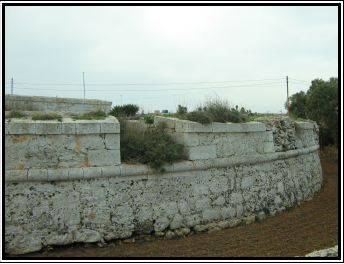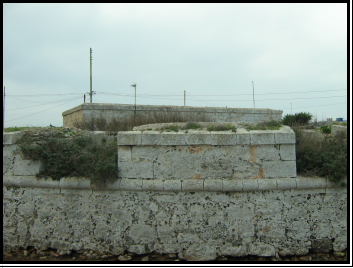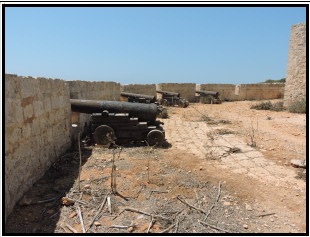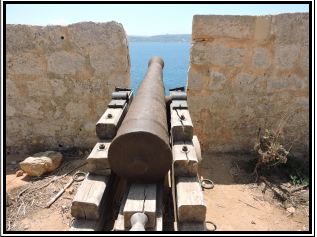VENDÔME BATTERY
Vendôme Battery was built in 1715–1716 as part of the first building programme of coastal batteries in Malta. It was part of a chain of fortifications that defended the Fliegu Channel, between the northern coast of Malta and Comino.
The battery was named after Philippe de Vendôme, the Prior of France, who donated 40,000 scudi to construct batteries and redoubts around Malta’s coastline. Several other fortifications were named after Vendôme, including a tour-redoubt in Marsaxlokk and a number of redoubts.
Vendôme Battery was one of the largest batteries to be built in Malta. It has a central blockhouse and a semi-circular wall with nine embrasures for artillery pieces facing the sea. At the two extremities of this wall one finds four shorter stretches of walls from where emerge the two back walls forming the redan. Around the whole coastal battery there is a deep ditch for further defence. The blockhouse is larger than those of other coastal batteries or coastal redoubts and it has a door and two windows facing seawards together with a single door at the back facing

Part of the semi-circular parapet wall with two embrasures for the two cannons. The ditch is filled with soil. Parallel to the wall is seen part of the blockhouse.

Frontal part of the semi-circular parapet wall with two embrasures for the two cannons. Again parallel to the wall is seen the upper part of the blockhouse and its roof.

A typical gun platform of a coastal battery showing four 6-pdr cannons in their embrasures. This particular example is found at Comino Battery

A typical 6-pdr cannon in its embrasure. One can see part of the frontal view of the battery which is the Fliegu opposite the northern coast of Mellieħa.
the redan. It costed 1059.1.9. scudi. Part of the expenses went on works on each two muri a due facciate which costed 158.9.15 scudi and 76.10.13.4 scudi respectively, the contrascarpa costed 146.6.7.4 scudi, the scavazione costed 120.3.15 scudi, the canali stimati costed 100 scudi.
On 4 October 1769, the Congregation of War made a report about the actual situation in the coastal fortifications, in terms of artillery pieces. The report showed how the coastal fortifications, including those of Mellieħa had been depleted in regarding artillery pieces. They were probably taken to be used elsewhere, especially on the Hospitallers’ warships in the previous years. The following is the report on Vendôme Battery:
Vendome Battery
There were 8-pdr cannons, but now is disarmed, and the utensils remain for the cannons that was armed with.
A year later, an artillery inventory was made in the Mellieħa coastal batteries, and we know that there were the following items in Vendome Battery:
Vendome Battery
Iron cannons 8-pdr = 3
Iron cannons 12-pdr = 3
Naval carriages = 11
Iron cannon balls 8-pdr = 210
Grape shots of 8-pdr = 45
Blackpowder conserved in St. Agatha Tower = 4.70.1
An artillery inventory was prepared by the Knight St. Felix on 3 October 1785, which showed the situation in the same coastal fortifications and how many pieces of artillery and other utensiles and necessary items they had. The following is the list of artillery pieces in Vendôme Battery:
Vendome Battery
Iron cannons 12-pdr = 4
Iron cannons 8-pdr = 5
Naval carriages = 11
Iron cannon balls 12-pdr = 280
Iron cannon balls 8 pdr = 350
Canister shots 12-pdr = 60
Canister shots 8-pdr = 75
In early November 1792, a number of artillery pieces of different calibre were distributed in various coastal fortifications, some of them in the coastal fortifications of Mellieħa. The following is a list of the calibre of the guns and their number in Vendôme Battery:
On 5 November 1792, the Congregation of War ordered that guards to be sent to the Vendôme Battery: